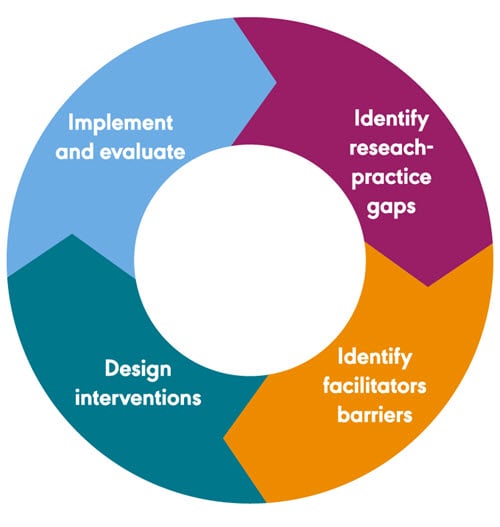How to Plan and Fund IPE/IPP Research
Most audiologists and speech-language pathologists routinely collaborate with professionals in other disciplines. However, training programs are typically still isolated by discipline. Why is that? One key reason is that educational programs need further research. In order to incorporate interprofessional education (IPE) and interprofessional practice (IPP) into training programs, our profession needs a better understanding of best practices and how IPE/IPP impacts those we serve.
If you have an idea for an IPE/IPP research study, the following resources will help you define your study, secure funding, and measure outcomes. For existing IPE/IPP research, check out our research and data page.
Planning Your IPE/IPP Research
Advice for Planning Your Research
Interprofessional education and practice has been a part of health care for decades. The Institute of Medicine, now the National Academy of Medicine, has been promoting IPE and IPP for more than 40 years. However, many audiologists and speech-language pathologists have only started to formally incorporate IPE/IPP into their work. There is a need for high-quality, cross-sectional, and longitudinal research to address key gaps in knowledge within our discipline and across other disciplines.
The following questions are a starting point for additional research:
- Interprofessional education (IPE) takes many forms. How do different types of IPE help learners develop the skills they need for professional practice?
- Do student clinicians incorporate their IPE knowledge into their clinical cases?
- What are the longitudinal effects of IPE on IPP?
- What are the effects of IPP on client or patient outcomes?
- What are the costs and benefits of IPP? How do those differ across settings?
- Successful IPP often requires developing new skills. How can we effectively measure professionals’ aptitude for these competencies?
Further Resources for Planning Your IPE/IPP Study
Before you start planning your research study, make sure you understand the current needs for IPE/IPP research. Review the latest available evidence on IPE/IPP. Also, these academic papers identify gaps in current research and provide guidance on terminology related to IPE/IPP.
Guidance on Global Interprofessional Education and Collaborative Practice [PDF]
By: IPR.Global and Interprofessional.Global
This research discussion paper from IPR.Global and Interprofessional.Global identifies research priorities and provides guidance on theoretical frameworks, research methodologies, and research teams. Also included is a proposed lexicon to use in your research. This serves as a working document as the field develops consensus on terminology related to interprofessional education, learning, practice, and care.
Considering the Complete Definition of IPE: The Future of IPE Research
By: Jennifer B. Watson, PhD, CCC-SLP
This article examines the gaps in research about IPE. Dr. Jennifer Watson explains that the existing IPE research focuses narrowly on program evaluations and learner outcomes. The field needs more investigation into the longer-term questions of how IPE leads to effective collaborations in work settings and how IPE impacts patients/clients. If you are planning a study of IPE, read this article for a better understanding of what types of research are most needed.
Moving From Interprofessional Education Toward Interprofessional Practice: Bridging the Translation Gap
By: Imran Musaji, Trisha Self, Karissa Marble-Flint, and Ashwini Kanade
In this comprehensive review of existing IPE and IPP research, the authors found increased support for IPE and IPP and improved attitudes toward interprofessional collaboration. However, they also uncovered a need for more evidence of successful outcomes, such as changed clinician behaviors, changed organizational practices, or improved patient outcomes. The authors discuss next steps for translating IPE to IPP.
Towards a Greater Understanding of Implementation Science in Health Professions Education
By: Thomas Aliki, PhD, OT; André Bussières, PhD, DC
Implementation science is an evidence-informed approach advocated for use in health professions education. It is designed to promote the uptake of research findings into educational, practice, and policy contexts. An implementation science framework can be used to identify IPE/IPP research-practice gaps and guide you in conducting collaborative research by following the steps outlined below.
- Identify Research-Practice Gaps – Consider existing research-practice gaps to identify an IPE/IPP research need that you could address with a research study.
- Identify Facilitators and Barriers – Identify existing resources and collaborators that could facilitate your research and help you mitigate any barriers.
- Design Interventions – Determine the most appropriate research methods and outcome measures. Explore strategies to seek collaborative scholarship opportunities.
- Implement and Evaluate – Implement your study design and assess the success of the outcome measures for your research question as well as the success of the collaboration.
An Implementation Science Framework for Planning Your IPE/IPP Research
How to Measure Your IPE and IPP Outcomes
Another important component of planning research is deciding how you will measure outcomes. These resources from the National Center on Interprofessional Practice and Education outline the fundamentals of IPE/IPP assessment and provide access to a collection of measurement instruments that you can use in IPE/IPP research.
Planning how to assess the outcomes is a critical step in preparing for effective IPE and IPP implementation and research. Researchers need to consider who will be assessed (e.g., student, clinician, team); what you intend to assess (e.g., acquisition of knowledge and skills, methods of education or practice, care outcomes); and the appropriate assessment methods to use. The National Center’s collection of resources advises researchers on what to consider when selecting a measurement tool, how to use qualitative or quantitative methods to collect and analyze data, and how to assess an IPE program or collaborative practice teamwork. This collection also provides real-life assessment examples from the field.
Funding Your IPE/IPP Research
Who Funds IPE and IPP Research?
Start your funding search by looking at intramural funding available within your own organization, funding from private foundations, and funding from government agencies.
Intramural Funding
The best way to secure intramural funding is by building strong relationships and networks across your institution. Demonstrate the importance of IPE and IPP research to those in charge of funding, such as your institution’s committees and development/foundation office. Increase awareness of the importance of IPE and IPP research by taking the following actions:
- Demonstrate how students will benefit from IPE and IPP research. For example, create a plan to involve students in the research.
- Tie IPE and IPP research to the institution’s strategic plan or initiatives.
- Highlight how IPE and IPP research will strengthen relationships with community stakeholders.
- Develop and promote experimental courses across disciplines, professions, and colleagues as a first step toward designing research questions that require funding.
Funding From Private Foundations
Some private foundations also offer funding for IPE and IPP research. Here are some examples:
Funding From Federal Agencies
Federal agencies also offer funding for IPE/IPP research. Such agencies include the following:
- Agency for Healthcare Research and Quality (AHRQ)
- Health Resources & Services Administration (HRSA)
- Institute of Education Sciences (IES)
- National Center for Education Research (NCER)
- National Center for Special Education Research (NCSER)
- National Institutes of Health (NIH)
- National Institute on Disability, Independent Living, and Rehabilitation Research (NIDILRR)
- U.S. Department of Education, Office of Special Education Programs (OSEP)
- U.S. Department of Veterans Affairs (VA)
Tips for Identifying and Applying for Funding Opportunities
Don’t be discouraged if you do not see grants specifically for IPE and IPP research. In fact, very few agencies currently offer grants only for IPE and IPP projects, but this doesn’t mean that funding is not available. Instead, broaden your search to include grants for studies that don’t have a specific content focus (e.g., “NIH Research Project Grants”) or that are broad enough to encompass IPE and IPP work (e.g., “interdisciplinary projects”).
As with any proposal submission, it is important to take the following steps before submitting your proposal:













